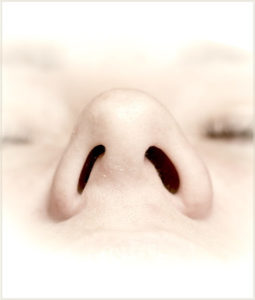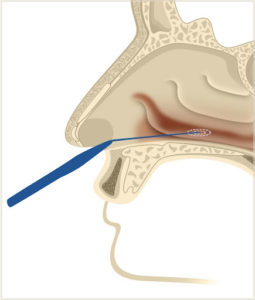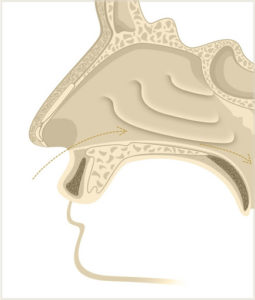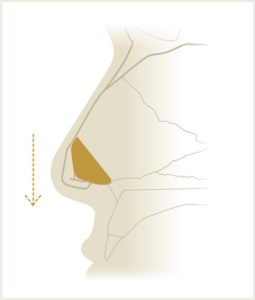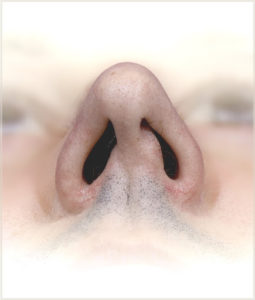Nasal obstruction is a term that refers to any disorder that hinders or blocks airflow in one or both nasal passages. Nasal blockage is typically caused by anatomical factors or temporary swelling of the nasal tissues which results in the narrowing of the nasal cavity and the restriction of the airway passages. Disorders that cause nasal obstruction include enlargement of inferior turbinates, enlarged adenoids, deviated septum, nasal polyps, tumors, and nasal congestion caused by allergic rhinitis, sinusitis, environmental irritants, and sinus infections.
Nasal Obstruction Surgery in NYC
Dr. Cangello has extensive experience correcting nasal obstruction stemming from a variety of anatomical nasal disorders. He understands that difficulty breathing through the nose as a result of nasal obstruction can lead to reduced quality of life, sleeping disorders such as obstructive sleep apnea (OSA), and snoring. If you have nasal obstruction caused by an anatomical blockage, Dr. Cangello can help. He specializes in a range of surgical treatments for nasal obstruction that open the nasal passages and improve nose breathing.
Symptoms of Nasal Obstruction
- “Nasally” voice
- Nasal drainage
- Chronic nasal congestion
- Recurring sinus infections
Contact plastic surgeon Dr. David Cangello today at (646) 665-4222 to schedule a consultation for Nasal Obstruction surgery in NYC.
Nasal Obstruction Treatments
There are many treatment options for nasal blockages depending on the disorder causing the nasal airway obstruction. Dr. Cangello will perform a comprehensive physical exam of the nasal anatomy to identify the cause of the nasal obstruction, and will then determine the most appropriate treatment plan based on his findings. While temporary causes of nasal obstructions resulting from allergies, cold, or flu can be treated with antihistamines or decongestants, patients with anatomical irregularities may require surgery to expand nasal airways and improve nasal breathing. Common surgical treatments to correct nasal obstruction include:
Septoplasty
Septoplasty is indicated for patients with nasal obstruction resulting from a deviated septum. A septal deviation refers to a septum that is asymmetrical or crooked due to trauma or anatomical defect. A septoplasty is a surgical procedure that straightens the septum, which is essentially a wall made of cartilage and bone that divides the two nasal passages.
While everyone has asymmetry of the nostrils to some extent, patients with a deviated septum typically can present with one nostril that is significantly smaller than the other if the caudal portion of the septum is deviated. When this occurs the columella (the column of cartilage and skin that divides the nasal passages) can be deviated to one side, thereby decreasing the size of the nostril on the side of the deviation (Fig. 1). This abnormality often translates into difficulty breathing through the smaller nostril. In addition to inhibiting breathing function, a deviated septum can also cause cosmetic irregularities. For example, when viewed from the front, a deviated septum can make a nose appear crooked (Fig 2). The septum can also be deviated posteriorly, deeper inside the nose, and this may or may not create a visible cosmetic deformity. Posterior septal deviations are typically seen only on intranasal examination by your surgeon. A CT scan can also diagnose septal deviation. Regardless of whether a posterior septal deviation causes cosmetic deformity of the nose, if the deviation is significant enough to cause functional impairment of breathing, it should be surgically corrected.
Septoplasty, also called septal reconstruction or submucous septal resection, can be an open or closed procedure depending on where in the nasal cavity the septum is deviated. Learn more about septoplasty here.
Turbinate Reduction
Turbinate reduction is indicated for patients with turbinate hypertrophy, or enlarged nasal turbinates. Turbinates are membranes inside of the nose that warm and filter air as it travels through the nostrils. The human nose has inferior, middle, and superior turbinates. During a normal “nasal cycle,” these turbinates activate in response to hormonal changes, stress, and irritants by increasing blood flow and causing them to swell in size.
Turbinate hypertrophy causes functional impairment of breathing when the turbinates are too large, and swelling becomes problematic inhibiting airflow (Fig 3). Turbinate hypertrophy can be caused by temporary disorders such as infections and irritants as well as anatomical irregularities and lead to an excessive amount of mucus production causing nasal obstruction.
Turbinate reduction surgery can be performed using one of two methods. Depending on the patient’s needs and anatomy, Dr. Cangello will determine if simple turbinate outfracture or partial turbinate resection with mucosal reduction is an effective solution for reducing the size of the enlarged turbinates to improve nasal breathing (Fig. 4). Learn more about turbinate reduction here.
Subtotal Septal Resection
Subtotal septal resection is indicated for patients with nasal obstruction resulting from a deviation to the portion of septum located behind the columella (called the caudal septum) or anterior most segment of the nasal septum (referred to as the dorsal septum).
The caudal septum’s main function is to support the nasal tip. If the caudal septum is deviated, or is over-resected or removed in a prior nasal surgery, the tip of the nose may partially or completely collapse, causing nostril asymmetry and/or a drooping nasal tip (Fig. 5). This can lead to difficulty breathing through the nose as the airway becomes obstructed on one or both sides (Fig. 6).
Subtotal septal resection requires nasal reconstruction using an open rhinoplasty approach. Dr. Cangello begins this complex procedure by making a small incision at the base of the columella to expose the caudal septum and insert a nasal speculum to spread the medial crura and expose the pertinent anatomy required for cartilage grafting.
Dr. Cangello will then remove as much septal cartilage required to eliminate the deviation and then replace this nasal segment with a new caudal septum to support the nasal tip, fashioned from a straight piece of harvested nasal cartilage.
This cartilage is grafted to the surrounding bone and cartilage, and the medial crura then sewn to the new caudal septum to establish proper nasal tip position and thus creating more symmetrical nostril openings for improved airways and nasal breathing (Fig. 7).
External Nasal Valve Collapse
External nasal valve collapse can occur as a result of over resection of cartilage from prior rhinoplasty or congenital deformities such as weak lower lateral cartilages which don’t provide sufficient support to the nostrils.
External valve collapse typically presents as the nostrils on one or both sides completely or partially collapsing inward when breathing. Surgery for this condition requires reshaping and strengthening the alar rim and surrounding cartilage with cartilage grafts using a marginal incision or alar-facial stab incision. This grafted cartilage can be harvested from the septum, rib, or ears.
External valve collapse correction can be an open or closed rhinoplasty procedure, and reinforcing the affected cartilage will effectively keep the external valves from continuing to collapse.
Nasal Obstruction Surgery in NYC with Dr. Cangello
Contact NYC’s leading nasal surgery specialist today to learn more about Nasal Obstruction surgery or to schedule a consultation.
1 Mayo Clinic. Septoplasty. Available: https://www.mayoclinic.org/tests-procedures/septoplasty/about/pac-20384670#:~:text=Septoplasty%20(SEP%2Dtoe%2Dplas,known%20as%20a%20deviated%20septum. Accessed July 30, 2021.
2 The Laryngoscope. External nasal valve collapse repair: the limited alar-facial stab approach. Available: https://pubmed.ncbi.nlm.nih.gov/21344421/. Accessed October 8, 2021.

